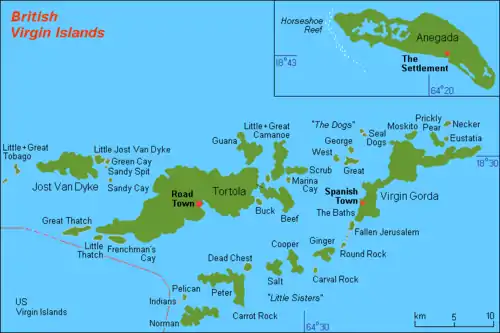Administrative districts

The five administrative subdivisions mentioned on some web pages are just statistical divisions, without any administrative relevance:
| Subdivision | Main town | Area km2 | Population (2010 census) |
|---|---|---|---|
| Anegada | The Settlement | 38.6 | 285 |
| Jost Van Dyke | Belle Vue (Jost Van Dyke) | 8.3 | 298 |
| Tortola | Road Town | 59.2 | 23,419 |
| Virgin Gorda | Spanish Town | 21.2 | 3,939 |
| Other Islands | Great Harbour (Peter Island) | 23.7 | 122 |
| British Virgin Islands | Road Town | 151.0 | 28,054 |
The "Other Islands" are mainly the islands south of Tortola (separated from it by the Sir Francis Drake Channel and southwest of Virgin Gorda and detached Ginger Island, mainly Norman Island, Peter Island, Cooper Island and Salt Island. These islands are also known under the informal name Little Sisters or Southern Islands.
The present-day Administrative Districts of the British Virgin Islands were established since 2003, following the provisions of the Sister Islands Programme, 2003.[1]
Tortola, the surrounding islets, and the Little Sisters/Southern Islands are directly administered by the BVI Government, as an "Island". The 3 "Sister Islands", including the neighbouring islets, are administered through 3 Districts, run by District Officers, under the Deputy Governor of the BVI[2] "in order to monitor, promote and facilitate the delivery of Government services to the sister islands of Virgin Gorda, Anegada, and Jost Van Dyke". This administrative setting is similar to that of some existing or former British dependencies - The Bahamas, Turks and Caicos Islands, or the Cook Islands - among others.
The Sister Islands Programme, 2003, establishes a Coordinator which works with, and supervises the District Officers, as a liaison with the central government.[3] There are no local government structures in the Territory.
Civil registry districts
There are six Civil Registry Districts in the British Virgin Islands:
| Civil Registry District | Area |
|---|---|
| District A | Virgin Gorda |
| District B | Anegada |
| District C | East End (Tortola) |
| District D | Road Town (Tortola) |
| District E | West End (Tortola) |
| District F | Jost Van Dyke |
Civil Registry Districts C, D and E are subdivisions of the main island Tortola.
Electoral districts
- By the Constitution and Elections Ordinance 1954, which established a new Legislative Council with an elected majority, the presidency was divided into five districts. Road Town District (area of the capital) sent two members to the legislative council, the other districts one each.
- A new constitution of 1967 provided for seven electoral districts, with one representative per district.
- In 1977, the number of electoral districts was augmented to nine. Each electoral district sends a member to the Legislative Council, which has 13 seats (including four at large members).[4]
| Electoral District | Area |
|---|---|
| First | West End, Carrot Bay (Tortola) |
| Second | Meyers, Cane Garden Bay, Brewers Bay (Tortola) and Jost Van Dyke |
| Third | Sea Cow's Bay and surroundings (Tortola) |
| Fourth | Road Town and surroundings (Tortola) |
| Fifth | Hunthum's Ghut and Long Trench (Tortola) |
| Sixth | Baugher's Bay and East Central Tortola |
| Seventh | Long Look (Tortola) and Beef Island |
| Eighth | East End, Greenland and Hope Estate (Tortola) |
| Ninth | Virgin Gorda and Anegada |
References
- ↑ "An Environmental Profile of the Island of Anegada, British Virgin Islands 2013" (PDF). irf.org. Retrieved 20 September 2023.
- ↑ Government document bvi.gov.vg Budget Estimates.pdf
- ↑ Wheatley Sister Islands Appointed Programme Coordinator Archived 17 June 2016 at the Wayback Machine
- ↑ "Electoral Districts in the British Virgin Islands". www.caribbeanelections.com. Retrieved 21 July 2022.
.svg.png.webp)